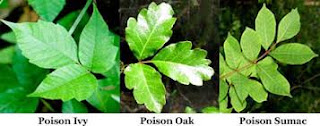Hiking is a great outdoor activity for any season, but especially in the summer and fall months. Whether you choose to travel on a paved path in the local park or trek through thickets and trees in the timberlands, preparing in advance can make for a safer, more enjoyable experience.
Be Prepared:
I have a backpack that is stocked and ready for any
expedition. It includes:
- Sunscreen
- Insect Repellent
- Binoculars
 |
| Binoculars are Great to take on a Hike! |
- Bandages
- Small Water Bottle
- Whistle

Whistles for Safety - Inexpensive rain poncho
- Snack Bars or Trail Mix
- Hand Sanitizer
- Tissues or a small roll of toilet paper
- A plastic bag for trash
Children should carry a backpack that weighs not more than
10-15% of their body weight. For
example, an average 7 year old weighs 50-60 pounds; their pack should not weigh
more than 5-9 pounds.
 |
| Don't overload your child's backpack! |
What to Wear and Take:
- Long, loose sleeved shirts allow air flow but protect against sunburn, discourage ticks and mosquitos, and help prevent scratches.
- Hiking boots that fit well with absorbent cotton socks. Try to “break-in” the boots slowly by taking short hikes or wearing them around the house before tackling a longer hike. A sturdy pair of tennis shoes also works well.
- Consider a wide-brimmed hat that can be great protection from the sun.
- Each person should wear or carry a whistle for emergencies.
- Spray bug repellent around the cuffs of sleeves and neckline of shirts and at the ankles.
- Apply sunscreen to exposed skin.
- Take at least 1 8-ounce bottle of water or Gatorade.
- If available, take a map of the park or area you plan to hike. (This can be a great teaching tool. Consider taking a compass and/or GPS tracker, too!)
- A walking stick can be helpful for longer hikes or paths traversing hills and mountains.
Teach children safety:
- Teach the “Buddy System”—each person should be paired with a family member or friend. It is each person’s responsibility to know where their partner is at all times. Make sure that everyone understands the importance of staying together--no one should wander off alone.
- If someone should become separated from the group, they should blow their whistle (ideally the “SOS” pattern of 3 long blasts, 3 short blasts, and 3 long blasts).
 |
| Instruct Children to Blow their Whistle if the are Lost |
- Instruct children to identify and avoid contact with poisonous plants like poison ivy and poison oak.
 |
| Poison Oak |
Additional Options:
- Have someone bring a bird identification book.
- Download an app to a smart phone that can help identify leaves and trees.
- Study in advance the insects or small animals you might see on your excursion.
Remember to Enjoy Every Moment! Give Thanks for the Beauty around Us!
Blog Administrator: Trisha Roberts
proeducationaltoys@gmail.com
Copyright © 2017 TNT Inspired Enterprise, LLC, All rights reserved.
Unauthorized duplication is a violation of applicable laws.






No comments:
Post a Comment